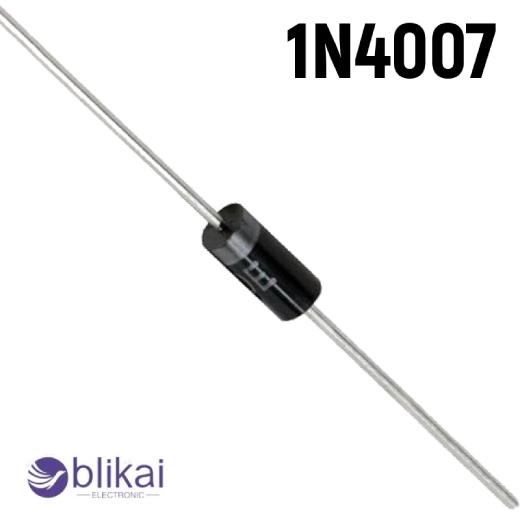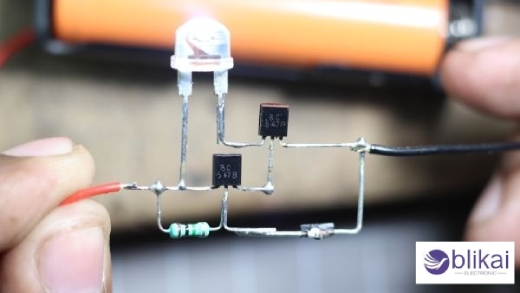What is a 1N4007 Diode and How Is It Used in Circuits?
Introduction to the 1N4007 Diode
The 1N4007 diode is a fairly popular general- purpose rectifier diode enjoying high voltage capability as well as a large current carrying range; hence, it finds wide operation in power electronics, rectification circuits, and power inventories.

Key Characteristics of the 1N4007 Diode
The 1N4007 is a well- known general- purpose rectifier diode in electronics for continuity and versatility. Here are its key characteristics:
1. Reverse Voltage (VRRM): 1000V-pk reverse voltage rated allows this diode to be used at 1000V. Thus, no breakdown occurs, enabling high-voltage applications.
2. Forward Current (IF): 1000V-pk reverse voltage rated allows this diode to be used at 1000V. Thus, no breakdown occurs, enabling high-voltage applications.
3. Surge Current (IFSM): Its maximum surge current rating is 30A; thus, it can handle higher currents for short durations (power-on surge).
4. Forward Voltage Drop (VF): Forward voltage drop at around 0.7-1.1V when 1A flows; for silicon rectifiers, that's fairly standard.
5. Recovery Time (trr): Recovery time is a little diverse, with this being the case with different kinds of diodes. Low-frequency applications up to 1 kHz are generally used for this diode.
6. Power Dissipation: The 1N4007 can dissipate power up to 3W when mildly cooled.
7. Temperature Range: The temperature range at which it operates is from -55°C to +150°C.
Technical Specifications of the 1N4007 Diode
Breakdown Voltage and Current Rating
The 1N4007 diode is a popular rectifier diode; voltage ratings are rated at 1,000 volts and, therefore, are ideal for use with high-voltage applications. It can handle a continuous forward current of 1A, allowing for reliable operation in standard rectification and protection circuits.
Maximum Reverse Voltage and Forward Voltage Drop
The maximum reverse voltage for the diode 1N4007 is 1000V, which protects very well from reverse polarity. The forward voltage drop is about 0.7V in the case of forward current 1A, hence there is very little energy loss and current practically flows very well through low-voltage still circuits.
Operating Temperature Range and Power Dissipation
The working temperature of this diode is from-65 °C to 150 °C, giving it a wider range of operation possibilities. The diode is able to dissipate energy at an outside of 3 W, advancing itself to operations in which thermal stability is veritably material to performance.
Working Principle of the 1N4007 Diode
Explanation of How the 1N4007 Functions
This diode is a PN- junction rectifier; it allows a current to flow only in one direction. In forward- prejudiced conditions, it allows the inflow of current; under rear- bias conditions, it blocks current; therefore it protects the circuits against rear opposition and helps to effectively convert AC to DC.
Diode Polarity and Current Flow
There's an anode and a cathode in 1N4007, forward- prejudiced current overflows from anode to cathode. Diodes only allow current to flow in one direction, which makes them useful for rectification and is used to convert AC to palpitating DC by blocking the rear current.
Comparison to Other Rectifier Diodes
There's an anode and a cathode in 1N4007, forward- prejudiced current overflows from anode to cathode. Diodes only allow current to flow in one direction, which makes them useful for rectification and is used to convert AC to palpitating DC by blocking the rear current.
Applications of the 1N4007 Diode in Circuits
Power Supply Rectification
Therefore, the 1N4007 is applied mostly in AC to DC power supply circuits as the rectifier. In a rectifying process, it changes alternating current into direct current by allowing the current to flow in one direction and blocking it in reverse.
Flyback Diode in Inductive Loads
The time-reversal or flyback diode functions by controlling or freewheeling in the circuit where there are inductive loads like solenoids or motors. The diode protects a circuit against voltage spikes that occur when the inductor breaks suddenly and prevents damage to other components in the circuit.
Reverse Polarity Protection
The 1N4007 protects circuits against damage by reverse polarity in power circuits. If input power is connected wrong (reverse), the diode would block current and protect any sensitive downstream components.
Voltage Clamping and Overvoltage Protection
They can provide a voltage clamp for limiting the voltage to a safe level, or to protect the circuit against overvoltage situations. In this, the diode conducts when the voltage exceeds its threshold reference (forward) voltage, thus limiting the voltage to a safe level.
Surge Suppression
The 1N4007 is employed to suppress voltage surges whenever transients in voltage spikes generated cause damage to sensitive components, especially in power supply systems, like those switched by lightning or some other event.
DC-DC Converters
The diode serves in configuration for rectification at step-up or step-down in the circuitry of DC-DC converters in low-cost components for handling moderate voltage levels.
Inrush Current Limiting
The 1N4007 helps to prevent them on startup into circuits with very large capacitors or other extensive load conditions that draw substantial current on the initial rise, thereby diminishing chances of damaging these components.
Charge Pump Circuits
In low-power applications, the 1N4007 can be used in charge pump circuits to increase or decrease voltage using capacitors and diodes to create the required voltage levels.
Common Use Cases in Power Supply Circuits
The mainstream use of the 1N4007 is in its application as a bridge rectifier, voltage regulator circuit, and a snubber circuit, employed in power supply circuits for filtering out and protection of output voltage. Due to its versatility and robustness, it is widely used across various power applications.

1N4007 Diode in Power Supply Circuits
Explanation of the Rectification Process
Rectification is the process of moving from AC voltage to DC voltage in power supplies. The 1N4007 diode, conducting in only one direction, blocks the negative half cycles and allows for a pulsating DC output, which is then smoothed for use in DC applications.
How the 1N4007 Diode is Used in Bridge Rectifiers
When using the 1N4007 in a bridge rectifier circuit, the arrangement consists of four diodes in which the entire AC waveform is converted to DC. While each pair of diodes allows current during opposite half cycles, full-wave rectification is possible using them for efficient conversion of AC to DC.
Benefits of Using the 1N4007 in Power Supplies
Due to its higher reverse voltage tolerance and ruggedness, it provides excellent service in power supplies due to its consistency while enduring voltage surges and fluctuating state. Its ability to handle up to 1A current and 1000V reverse voltage provides robust protection and efficiency in power circuits.
1N4007 vs. Similar Diodes
Comparison with Other Popular Diodes (1N4001, 1N4004, etc.)
The 1N4007 belongs to the larger series of diodes known as the 1N400x diodes, which vary in their current handling capacity depending on the maximum reverse voltage. The 1N4001 allows up to 50 volts, while the 1N4004 allows 400 volts, with the 1N4007 rated a peak at 1000 volts, thus making it a source of great flexibility for more delicate and simple high-voltage applications.
Advantages of the 1N4007 Over Similar Diodes in High-Voltage Circuits
The 1N4007’s high breakdown voltage and robust construction offer lesser protection in circuits exposed to voltage harpoons or surges. Its capability to repel up to 1000V makes it a superior choice for high- voltage and artificial operations taking dependable performance.
When to Choose the 1N4007 for Your Circuit
The 1N4007 is excellent to use if the application requires circuit operation at or above 400V; these include industrial power supplies, inverters, and AC/DC converters. It possesses the ability to withstand high voltages, given the durability it provides alongside safety in such voltage transients.
Practical Tips for Using the 1N4007 Diode
Best Practices for Soldering and Handling
Don't overheat the 1N4007 while soldering or it may damage the PN junction. Heat sink the PN junction or limit the soldering amount of time to 2-3 seconds. Handle the diode by its leads, not the body, to prevent static damage or mechanical stress.
Circuit Design Considerations
Ensure the 1N4007 is properly oriented, with the cathode towards the more negative voltage. Offset its voltage drop of around 0.7 volts in low voltage circuits and place an appropriate capacitor across it if it is used in a rectifier to reduce ripples.
Common Mistakes to Avoid When Using the 1N4007
Do not operate near any maximum ratings on either the current or voltage capacity, as this could lead to permanent damage to the diode. Always double-check your polarity; wrong orientation will just possibly ruin your circuit. Do not use in high-frequency circuits; it is meant primarily for use in low-frequency applications.
Related Articles
1N4005 vs 1N4007 DIODE:What are the Differences?
What is 1N4732A Zener Diode: Features and Its Working
1N4148 Diode: Features and its Applications
BAT54A Schottky Diode:Application,Features and Pinout
BAT54A Diode: Pin Configuration & Applications
1N4148 Diode: Features and its Applications
What is 1N4732A Zener Diode: Features and Its Working
What Causes Capacitors to Fail
Unveiling Polypropylene Capacitors: Principles, Applications, and Future Trends
Difference Between Serial and Parallel Communication
Regulated vs Unregulated Power Supply: What's the difference?
Semaphore in Embedded System
The Interconnection Between Semiconductors and Cybersecurity










